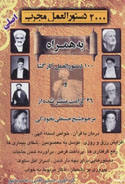What are the differences between Shia and Sunni Muslims؟
What are the differences between Shia and Sunni Muslims؟
The distinction between Shia and Sunni Islam began after the death of Islam's founder The Prophet Muhammad (PBUH&HP). Sunni Muslims believe that the Prophet Muhammad (PBUH&HP) did not name a successor to lead Muslims after his death while Shia Muslims deeply believe that the Prophet (PBUH&HP) Introduced Imam Ali (PBUH) for many times as his successor. Including in Qadeer Khom where the Prophet raised Imam Ali's hand then introduced him as the Imam for all Muslims and commanded Muslims (more than one hundred thousand Muslim) there to give Imam Ali allegiance.
As a result, Sunnis believe that people after the Prophet death elected a new leader. The first four caliphs, began the Sunni tradition, though no global Sunni leader has been in place since the fall of the Ottoman Empire.
In contrast, Shia Muslims followed Imam Ali ibn Abi-Talib (PBUH), the son-in-law of the Prophet Muhammad (PBUH&HP), as the rightful successor of Islam. While Sunni movement has developed into many sub-groups, Shia Muslims emphasize the special spiritual and political leadership of Imams (Muslim religious leaders) to Muslim nations.
In terms of size, Sunni Muslims are the largest group of adherents within Islam, with close to seventy percent of Muslims coming from Sunni heritage. However, in certain countries, including Azerbaijan, Bahrain, Yemen, Iran, and Iraq, Shia Islam is considered the majority groupand in many of other Islamic countries like Saudi Arabia, Afghanistan, Pakistan, Syria and many other countries are minority.
Spiritually, both groups practice the Five Pillars of Islam. All Muslims have to pray five prayers that Sunni Muslims pray these five prayers in five times each day (separately), while Shia Muslims pray them in three official times (together). Further, All of Shia and few of Sunni Scolars and Muslims accept the belief in the Twelfth Imam who has already been born but is hidden and will play a major role with his return in the last days.
Each group also has other unique traditions as part of its religious customs. For example, Shia Muslims observe the Day of Ashura, a day to commemorate the martyrdom of Imam Husayn ibn Ali (PBUH), grandson of the Prophet Muhammad (PBUH&HP).
Sunni Muslims follow the many Hadith that are considered authenticated sayings of the Prophet Muhammad (PBUH&HP) to help interpret the Glorious Qur'an. Shia Muslims do not accept the authority of the six major Hadith collections of Sunni Islam but instead follow the Hadiths that is narrated from infallible twelve Imams.
In a religion as large as Islam, many additional subgroups also exist within Sunni and Shia Islam. These differences note some of the major distinctions. Yet all Muslims continue to follow Allah as the one true God, the Five Pillars of Islam, and share many important spiritual and cultural customs related to their religions.
Interestingly, both Sunni and Shia Islam accept the Muslim teaching that Jesus (PBUH) is one of many prophets in Islam. Yet the Bible (composed of Old and New Testaments) is the book in which many of the historic teachings of Moses and Jesus (PBUTH) can be found.
مطالب مشابه با این موضوع:
وبگــــــــــردی طلبۀ پاسخگو
- فایل اعمال و رفتار های خلاف قانون جناب آقای حسن روحانی
- در کنج خانه طلبهها چه میگذرد؟
- سکوت چند ساله مسئولان حوزه در قبال حملات وحشیانه به طلاب!
- می گویند که مملکت مملکت آخوندهاست!!
- یک ماجرای تلخ که خانم ها با تأمل بیشتر بخونند
- جریان های تکفیری موجود در عراق و نحوه شکل گیری آنها
- سیر تکاملی تفکر سلفیه چگونه بوده است؟
- بداء در قرآن و حدیث چگونه مطرح شده است؟
- پیامبر (ص) با مخالفین خود چگونه بر خورد می کرد؟
- سبک زندگی حضرت زهرا سلام الله علیها
- ملاک کرامت و شرافت افراد، انسانیت است یا جنسیت؟
- رنگ و پوشش های رنگی در اسلام
- حجاب، زنان را افسرده میکند و مانع پیشرفت اجتماعی آنهاست!!!
- علوم لدنی معصومین
- مگر ولی فقیه معصوم است که ولایت مطلقه دارد؟
- اگر خدا ازعاقبت ما اطلاع دارد قیامت برای چیست؟
- آیا بجای نماز خوندن، پیانو یا سه تار بزنم؟
- چرا مراسم عزاداري امام حسين(ع) پيش از شهادت ايشان صورت ميگيرد؟
- چرا امام حسين(ع) در كربلا براي رفع تشنگي از خداوند طلب باران نكرد؟
دانــــــلود های مفیـــــــــــــــــــد
- دانلود پاورپوینت شناخت وهابیت و صهیونیسم و ارتباط با همدیگر
- دانلود دو پاورپوینت اجرای عید غدیر خم
- دانلود پاورپوینت احتجاج اميرمؤمنان (ع) به غدير
- پژوهشی در کلام و پیام مقام معظم رهبری پیرامون ماه رمضان
- خطبه شعبانیه و خطبه امیرالمومنین(علیه السلام) پیرامون روزه و ماه رمضان
- دانلود پاورپوینت و pdf تفاوت های زن و مرد
- دانلود جزوه ساعات سعد و نحس(زمان نوشتن دعا)
- تقویم مذهبی شمیم یار 96 مخصوص کامپیوتر
- دانلود نرم افزار «شیعه شناسی»
- دانلود پاورپوینت ساختار خانواده و مسایل آن
- دانلود کتاب دایره المعارف جنسی
- دانلود نکات جذاب دوران عقد
- دانلود کتاب درمان سرد مزاجی و بی میلی جنسی بانوان
- دانلود کتاب حسادت کودکان
- دانلود کتاب درمان خستگی وناتوانی جنسی
- دانلود پاور پوینت اسیب های ازدواج وخانواده
- دانلود پاورپوینت هشت گام برای تحقق رویا به واقعیت
- دانلود پاورپوینت تقویت اراده
- دانلود پاورپوینت موفقیت وروشهای رسیدن به ان
- دانلود پاورپوینت هنر رفتار با افراد دشوار
- دانلود پاورپوینت جملات جالب وجذاب روحیه بخش بزرگان
- دانلود پاورپوینت راههای مقابله ودرمان استرس
- دانلود پاورپوینت نیازهای اساسی کودکان
منبــــرهای مکــــــــــــــــــتوب
- منبر مکتوب: روز عرفه و فرصت ها
- منبر مکتوب: سبک زندگی امام باقر علیه السلام
- منبر مکتوب: سه نیاز مومن (امام جواد علیه السلام)
- سخنرانی سلسله ای و چند جلسه ای مناسبت ماه رمضان
- دانلود 30 جلسه سخنرانی ماه مبارک با موضوع تنها مسیر
- موضوعات پیشنهادی سخنرانی برای محرم
- فضائل حضرت قمر بنی هاشم علیه السلام
- برکات وجود ابا عبدالله علیه السلام بر عالم
- بررسی بُعد اخلاقی،عبادی و عرفانی عاشورا
- آخرين وصيت امام حسين عليه السلام
- اولین علت رویاروی در کربلا؛ دوری از یاد خدا
- هميشه حزن؟ شادي چرا نه؟ - شب دهم محرم
- چرا نفرين ؟ - شب نهم محرم
- نماز ظهر عاشورا - شب هشتم محرم
- فلسفه عزاداری - شب هفتم محرم
- دفاع از دین - شب ششم محرم
- فلسفه حضور خانواده سيد الشهداء - شب پنجم محرم
- علم امام علیه السلام به شهادت - شب چهارم محرم
- فقدان شرایط امر به معروف و نهی از منکر- شب سوم محرم
مناظرات طلبه پاسخگو
جدیدترین های زبان انگلیسی
- Islam and Its Social System
- Duties of Man Towards the People
- Islam Various Systems
- Attributes of The Real Follower of Imams in Their Teachings
- Who is a Real Shia Muslim?
- RIGHTS OF SCHOLARS
- Islam Attacks Slavery 1
- The Advantages of Religion 2
- The Clearest Reason for Free Will
- Sheikh Zakzaky to be released on bail
- Brief History of Religions
- Is It Necessary For Man To Follow A Religion?
- The Advantages of Religion 1
- Who Is Almighty Allah?
- What are the differences between Shia and Sunni Muslims؟
- The Rights Islam Offers to Women
- How I find that Islam does not Oppress Women?
- URGENT MEDICAL TREATMENT FOR SHEIKH ZAKZAKY
- The motto of this year’s book fair is “Reading Is Ability”.
- Fundamental principles of Islam
بیشترین دانلود ها
- دانلود صوتي تکنیک های نزدیکی زن و شوهر (108011)
- دانلود رایگان کتاب خواص سوره های قرآن (54634)
- دانلود پاورپوینت بسیار مفید مهارت های زندگی (37349)
- دانلود كتاب مسائل جنسي و زناشوئي در احاديث (33666)
- دانلود پاورپوینت و pdf تفاوت های زن و مرد (33632)
- دانلود کتاب دایره المعارف جنسی (31629)
- دانلود پاورپوینت های آموزش پیش از ازدواج (30424)
- دانلود بسیار مفید پاورپوینت آئین همسرداری (29775)
- دانلود پاورپوینت آموزشی بررسی رابطه دختر و پسر (29424)
- دانلود 110جلد کتاب بحارالانوار علامه مجلسی ره (29348)
- دانلود كتاب دختران خوب به آسمان می روند دختران بد به همه جا (28379)
- دانلود کتاب آموزش جنسی آقایان (28186)
- دانلود كتاب فرق و مذاهب كلامي استاد رباني گلپايگاني (28102)
- دانلود کتاب درمان سرد مزاجی و بی میلی جنسی بانوان (27865)
- دانلود نکات جذاب دوران عقد (27384)
- دانلود نرم افزار «شیعه شناسی» (25693)
- دانلود کتاب درمان خستگی وناتوانی جنسی (24964)
- دانلود پاورپوینت تقویت اراده (23448)
جدیدترین مطالب سایت
- پاسخ به شبهات ولایت (4629) بازدید
- پاسخ به شبهات ولایت (4417) بازدید
- اذان در جامعه اسلامی نماد چیست ؟ و چرا فقط سه بار در روز تکرار می شود ؟ (3860) بازدید
- باتوجه به عادل بودن خداوند چرا بعضی از انسانها را ناقص الخلقه آفریده است ؟ (3930) بازدید
- ویژگی خاص قرآن چیست که کسی نمی تواند مانند آن را بیاورد ؟ (4140) بازدید
- با توجه به ترک خود ارضایی عوارض آن هنوز در من هست چگونه آن را برطرف کنم ؟ (5554) بازدید
- آیا بدن اخروی مانند بدن مادی است ؟چهره ی واقعی انسان در قیامت چگونه است ؟ (4938) بازدید
- آیا ادعای ملاقات امام زمان (عج) از جانب برخی افراد صحت دارد ؟ (4429) بازدید
- چرا به اصول و قواعد دین اسلام توجه نمی شود و پذیرش آن از سوی پیروان ادیان دیگر سخت است ؟ (4801) بازدید
- فلسفه وجود لباس روحانیت در عصر حاضر چیست ؟ (3504) بازدید
- آیا وظیفه یک روحانی تنها راهنمایی مردم و فعالیت و تدریس در حوزه هاست ؟ (2919) بازدید
- آیا نظریه تناسخ از دیدگاه اسلام پذیرفته شده است ؟ (5166) بازدید
- آیا توصیف بهشت و جهنم در قرآن تمثیل هایی برای درک بهتر آن جهان است ؟ (4774) بازدید
- با توجه به اینکه اسلام کاملترین دین هست چرا ما نسبت به کشور های غیر مسلمان عقب مانده تر هستیم ؟ (6658) بازدید
- نقش امام و رهبر در جامعه اسلامی چیست ؟ و اگر نباشد چه اتفاقی می افتد ؟ (4479) بازدید
پربازدیدترین های سایت
- زنی هستم که میخواهم به شوهرم خیانت کنم!!! (605201)
- آيا زن شوهر دار بخاطر رفع نیاز جنسی اش ميتواند صیغه شود؟ (500904)
- دوست دخترم حامله شده چکار کنم؟ (398543)
- میل جنسی زیادی دارم و به شدت داره منو عذاب می ده (340429)
- دیدن فیلم های مبتذل زن و شوهر برای تحریک شدن جنسی (217759)
- چگونه همسرمان را آماده آميزش جنسي كنم؟+18 (213079)
- حکم شرعی نزدیکی از پشت! (207972)
- خانم هایی که می خواهند طلبه شوند بخوانند!!! (205388)
- زنم رابطه جنسی برقرار نمیکند!!! (199621)
- از تجربه های تلخ و تکان دهنده دختران بخوانید شاید... (172361)
- گناه با محارم خود داشتم! (146252)
- رابطه جنسی دهانی حكم چيست؟ (130676)
- محرمات و مکروهات و مستحبات حائض+حکم ورد به امکان مقدسه (129457)
- به رابطه خانمم با خواهر زاده اش مشکوکم؟ (123070)
- سفارش اسلام در مورد آمیزش صحیح چیست؟ (99020)
- نام كتاب حضرت نوح و حضرت ابراهیم؟ (96995)
- با زنان چشم سبز ازدواج نکنیم؟ (94677)


















